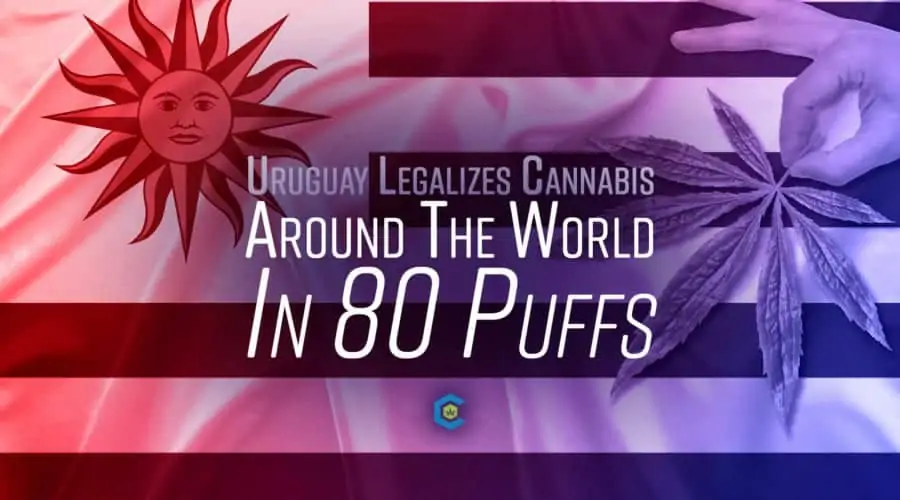Around the World in 80 Puffs: Uruguay
Do you know where Uruguay is? No, not there. Not there either. It’s a small country in Latin America and its capital, Montevideo, is just a short ferry ride away from Buenos Aires. Because it doesn’t get much international press, you may not be aware that Uruguay has a special place in cannabis’ global history.
Uruguay was the first country to fully legalize cannabis. Even the Netherlands, famous for having cannabis coffee shops, as of 2019 has only decriminalized cannabis for personal use up to 5 grams.
Uruguay has a population of just under 3.5 million citizens which is just .05% of the global population. This is less surprising when you look at a map and see the size of the country. Despite being small, Uruguay has a liberal history and a lot of lessons for the world as other countries begin their cannabis legalization process.
So let’s start this series by looking at Uruguay and its journey towards fully legalizing cannabis.
Brief History of Uruguay
Most people don’t know the history of Uruguay, so here are a few of the major events starting with the founding of Montevideo, the capital city.
1726 – The Spanish found Montevideo and take over the area from the Portuguese
1828 – Brazil and Argentina renounce claims to the territories which become the Eastern Republic of Uruguay.
1830 – Uruguayan constitution approved.
1962 – Tupamaros guerrillas begin their campaigns which last until 1973.
1973 – The armed forces snatch power on claims they’ll encourage foreign investment. Instead, they usher in an era of severe repression and earn Uruguay the reputation of being “the torture chamber of Latin America”. Uruguay has the highest number of political prisoners per capita in the world during this period.
1985 – Political leaders and the army agree to return to a constitutional government and to release political prisoners. A law is passed granting amnesty to the members of the armed forces accused of human rights violations during the dictatorship. Julio Maria Sanguinetti is president.
2003 – Financial crisis spanning several months. Tax increases are introduced, banks are shut down by the government for nearly a week, strikes are common. The World Bank approves loans totaling over $250million.
2004 November – Tabare Vazquez wins the presidential elections, marking a political swing to the left. Upon taking office, Vazquez signs an energy deal with Venezuela, restores ties with Cuba, and reveals a welfare package to alleviate poverty.
2006 December – Uruguay repays its billion-dollar debt to the International Monetary Fund.
2012 October – Uruguay becomes the first Latin American country (after Cuba) to legalize abortion for all women.
History of Cannabis in Uruguay
The history of cannabis in Uruguay is short but incredibly important as we study Uruguay as a model of legalization worldwide.
1974 – While drug trafficking remains illegal, the possession of a “minimum quantity of [cannabis], intended solely for personal use” is decriminalized. Acquisition of cannabis remains illegal.
2013 December – Uruguay becomes the first country in the world to legalize the cultivation, sale, and consumption of cannabis for recreational use. This is a measure to mitigate the power of drug cartels. The UN drugs watchdog claims this violates international law.
2017 July – Uruguay becomes the first country to legally produce and sell marijuana for recreational use.
Cannabis Culture in Uruguay
Cannabis is fully legal for recreational use. This means you’ll come across families smoking on las Ramblas in Montevideo and news articles debating the merits of cannabis for XYZ condition. The social stigma is gone and Uruguayans are able to partake as freely as they would like. The current cannabis laws allow Uruguayan residents to access a substantial amount of cannabis on a regular basis.
As of 2019, Uruguay has three options for legally accessing recreational cannabis:
- Buying up to 40 grams of cannabis out at any of the 17 sanctioned pharmacies
- Growing up to six cannabis plants at home
- Being a member at one of the 114 cannabis clubs.
In order to take advantage of any of these options, however, Uruguayan residents need to register with the Instituto de Regulación y Control de Cannabis. The exact registration process depends on whether you intend to buy cannabis at a pharmacy, grow cannabis plants at home, or join a cannabis club.
Cannabis Tourism in Uruguay
Does cannabis tourism exist in Uruguay? Yes and no. There are some interesting restrictions on who can and cannot purchase cannabis and CBD products in Uruguay, which has some impact on their cannabis tourism industry.
While cannabis tourism isn’t technically legal in Uruguay, it still exists by exploiting legal loopholes. As a non-resident of Uruguay, you can’t buy cannabis but it can be gifted to you by a resident. If you choose to move to Uruguay, you can register and be able to access cannabis directly, including for your non-resident Uruguayan friends, assuming you gift it to them.
The easiest way to explore the cannabis scene in Uruguay as a foreigner is by staying at a Bud and Breakfast in Uruguay. Some of their featured listings in Montevideo do not explicitly declare you’re going to be gifted cannabis as part of your stay (as that promise would make it a purchase and thus illegal) but some bud might just be part of your welcome basket.
While in Montevideo, you can visit the Montevideo Cannabis Museum and learn more about cannabis and it’s history in Uruguay and internationally. The museum is small but well laid-out and has a wonderful botanical garden that focuses on showcasing a range of different cannabis plants.
Uruguayan Cannabis and the World
While the Uruguayan cannabis market and industry didn’t get much global attention for the first few years after legalization, that is now changing.
In November 2018, the Canadian group Aurora inaugurated the first production center for medical cannabis in Uruguay. In addition to Aurora, another 32 groups have the Uruguayan regulatory agency Instituto de Regulación y Control de Cannabis’ approval to research and produce medical cannabis products.
As of early 2019, the Canadian company Silverpeak’s Uruguayan subsidiary Fotmer had requested IRCCA’s permission to increase their annual production permit to 400 tons of cannabis flowers. Already producing an estimated 6 tons this year, Fotmer could earn as much as $40 million in revenue, assuming it is able to export cannabis flowers and small amounts of THC and CBD extracts internationally to countries like Australia, Canada, Germany, and the United Kingdom.
What We Can Expect in the Next Few Years
As international companies continue to acquire permission to operate in Uruguay, the cannabis industry could grow rapidly in the next few years. 2019 is expected to be a year of rapid growth due to both international and local investment in research and growth facilities for cannabis.
While much of the cannabis crop is expected to be exported, this could be a boon for the Uruguayan economy as growing cannabis requires humans, which means jobs and tax revenue. The quality of cannabis and accessibility in Uruguay could improve, and more Uruguayan companies are expected to be approved as growers, processors, and vendors of cannabis in the next few years.
While Uruguay got a slow start as a global cannabis powerhouse, it’s not too late for them to have an impact on the global cannabis industry.


